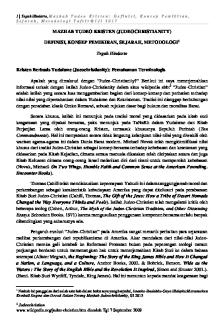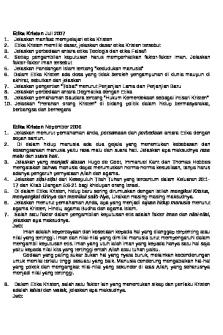Medadmin P - Kristen Needler PDF

| Title | Medadmin P - Kristen Needler |
|---|---|
| Author | Sydney Morrow |
| Course | Fundamentals Of Nursing |
| Institution | Indiana University - Purdue University Indianapolis |
| Pages | 5 |
| File Size | 64.3 KB |
| File Type | |
| Total Downloads | 14 |
| Total Views | 217 |
Summary
Kristen Needler...
Description
Medication administration: Medication: pharmacokinetics - Route: how enter the body - Absorption: from site into blood - Distribution: from blood into cells, tissues, or organs - Action: alter physiological functions - Metabolism: changed to prepare for excretion - Excretion: how they exit the body - Action: how medications act This knowledge is used when selecting timing, route, risks, and evaluating the response Medication: factors influencing routes - Oral: convenience vs tolerance, easy to give, often produces local or systemic effects - Injections: infection risk, needle, bleeding, rapid absorption - Skin/topicals: painless, caution w/ abrasions, provides local effects - Transdermal: prolonged systemic effects - Mucous membranes: sensitive, less pleasant - Inhalation: provides rapid effect for local respiratory effect, potential serious side effects Medication: forms - Caplet: coated for easier swallowing - Capsule: powder, liquid or oil in gelatin shell - Tablet: compressed powder - Enteric coated: dissolves in small intestine - Time release: granules with different coatings, or some tablets that dissolve slowly - Elixir: mixed with water or alcohol and a sweetener - Syrup: sugar solution - Suspension: drug particles in a liquid medium - Solution (mixed in water): can be sterile for dressing changes (normal saline) or for IM, SQ, or IV routes - Lotion: liquid suspension for skin - Ointment: semisolid (salve another name) - Paste: semisolid, but thicker than ointment- slower absorption - Transdermal disk or patch: semi-permeable membrane disk or patch with drug applied to skin - Suppository: solid drug mixed with gelatin inserted into body cavity to melt (rectum or vagina)
Medication: actions Therapeutic effect:
Side effect:
Expected or predictable
Unintended, secondary effect (ex. Ace inhibitor and cough)
(ex. Nitroglycerin increases myocardial oxygen supply) Adverse effect: Severe response to med (ex. Seizure)
Toxic effect: Medication accumulates in the blood stream (ex. morphine & respiratory depression)
Idiosyncratic reaction:
Allergic reaction:
Over- or under-reaction to a medication(ex. child/Benadryl)
Unpredictable response to a medication
Medication: interactions - Occur when one medication modifies the action of another - A synergistic effect occurs when the combined effect of two medications is greater than the effect of the medications given separately Medication: dose responses
Serum half-life:
Onset:
Time for serum medication concentration to be halved
Time it takes for a medication to produce a response
Peak:
Trough:
Time at which a medication reaches its highest effective concentration (IV vs. po)
Minimum blood serum concentration before next scheduled dose
Duration: Time during which the medication is present in concentration great enough to produce a response
Plateau: Blood serum concentration is reached and maintained
Administering vs inhalation - Aerosol spray, mist, or powder via handheld inhalers; used for respiratory “rescue” and “maintenance” - Pressurized metered-dose inhalers (pMDIs) - Need sufficient hand strength for use - Breath-actuated metered-dose inhalers (BAIs)
- Release depends on strength of pts breath Dry powder inhalers (DPIs) - Activated by pt’s breath Produce local effects such as bronchodilation Some meds create serious systemic side effects -
-
Administering via inhalation - Inhalers: spacer used when pt unable to work it correctly Prescriber’s role - Prescriber can be physician, nurse practitioner, or physician’s assistant - Orders can be written (hand or electronic), verbal, or given by telephone - The rn role in computerized provider order entry (CPOE) - The use of abbreviations can cause errors; use caution - Each medication order needs to include the pts name, order date, medication name, dosage, route, time of administration, drug indication, and prescriber’s signature Types of orders in acute care agencies Standing or routine:
prn:
Administered until the dosage is changed or another medication is prescribed
Given when the patient requires it
Single (one-time):
STAT:
Given one time only for a specific reason
Given immediately in an emergency
Now:
Prescriptions:
When a medication is needed right away, but not STAT
Medication to be taken outside of the hospital
Medication administration - Pharmacist’s role - Prepares and distributes medication - Distribution systems (unit dose or automatic medication dispensing system [AMDS]) - Area for stocking and dispensing medication - Nurse’s role - Assess patient’s ability to self-administer, determine whether patient should receive, administer medication correctly, and closely monitor effects, do not delegate this task - Medication error
Automated medication dispensing system
-
Automated: control the dispensing of meds, may be networked with computerized medical record, may include controlled substances
Medication errors - Report all medication errors - Patient safety is top priority when an error occurs - Documentation is required - The nurse is responsible for preparing a written occurrence or incident report: an accurate, factual description of what occurred and what was done - Nurses play an essential role in medication reconciliation Meds: seven rights - Right pt: 2 identifiers (name/ID/MAR) - Right drug: need order, match mar - Right dose - Right route - Right time: institutional - Right documentation: after it is given - Right to refuse Meds: nurse role - Follow 7 rights - Read labels 3x and compare to MAR - Use at least 2 patient identifiers - Avoid interruption - Double check calculations, verify with another RN, follow policy - Question unusual doses - Record after medication given - Report errors, near-misses - Participate in programs designed to reduce error - Patient education about medications Maintaining patients’ rights - To be informed about a medication - To refuse a medication - To have a medication history - To be properly advised about experiment nature of medication - To receive labeled medications safely - To receive appropriate supportive therapy - To not receive unnecessary meds - To be informed if medications are part of a research study
Medication: orders
-
Patient's full name Date and time order written Drug name Dosage Route Time and frequency Signature of provider
Essential components of medication administration - Check chart for new orders first - Medical history - Drug allergies/interactions - tolerance/appropriateness of route - Ordered diet - Clients knowledge, educate if necessary - And…. all 7 rights prior to administration a. liver or kidney problems b. trouble swallowing, nausea, or vomiting c. NPO for some reason d. post op GI patients – decreased motility e. gastric ulcer patients – avoid aspirin or anticoagulants f. check labs g. confused or unconscious clients may require alternate route h. age may also influence (anxiety with children and injections), (elderly with numerous meds) Nursing diagnoses related to medication administration -
Knowledge deficit regarding drug therapy related to unfamiliarity with information resources Noncompliance regarding drug therapy related to limited economic resources (or health beliefs) In effective management of therapeutic regimen related to complexity of drug therapy (or knowledge deficit) Impaired swallowing related to neuromuscular impairment...
Similar Free PDFs

Medadmin P - Kristen Needler
- 5 Pages

Injections P - Kristen Needler
- 13 Pages

Etika Kristen
- 26 Pages

Filsafat Kristen
- 31 Pages

Week Nine - Kristen Fryer
- 3 Pages

Makalah ETIKA KRISTEN II
- 6 Pages

IPTEK Dalam Pandangan Kristen
- 1 Pages

Historiografi Kristen Awal
- 36 Pages

MAZHAB YUDEO KRISTEN
- 39 Pages

Soal Tentang Etika Kristen
- 22 Pages

MAKALAH PENDIDIKAN AGAMA KRISTEN
- 26 Pages

HISTORIOGRAFI KRISTEN AWAL
- 15 Pages

PERNIKAHAN KRISTEN YANG HARMONIS.pdf
- 125 Pages

Tugas pendidikan Agama kristen
- 5 Pages

CAT Person, de Kristen Roupenian
- 15 Pages
Popular Institutions
- Tinajero National High School - Annex
- Politeknik Caltex Riau
- Yokohama City University
- SGT University
- University of Al-Qadisiyah
- Divine Word College of Vigan
- Techniek College Rotterdam
- Universidade de Santiago
- Universiti Teknologi MARA Cawangan Johor Kampus Pasir Gudang
- Poltekkes Kemenkes Yogyakarta
- Baguio City National High School
- Colegio san marcos
- preparatoria uno
- Centro de Bachillerato Tecnológico Industrial y de Servicios No. 107
- Dalian Maritime University
- Quang Trung Secondary School
- Colegio Tecnológico en Informática
- Corporación Regional de Educación Superior
- Grupo CEDVA
- Dar Al Uloom University
- Centro de Estudios Preuniversitarios de la Universidad Nacional de Ingeniería
- 上智大学
- Aakash International School, Nuna Majara
- San Felipe Neri Catholic School
- Kang Chiao International School - New Taipei City
- Misamis Occidental National High School
- Institución Educativa Escuela Normal Juan Ladrilleros
- Kolehiyo ng Pantukan
- Batanes State College
- Instituto Continental
- Sekolah Menengah Kejuruan Kesehatan Kaltara (Tarakan)
- Colegio de La Inmaculada Concepcion - Cebu
